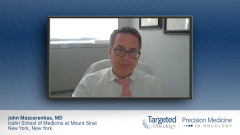
Future Directions for Myelofibrosis Treatment
John Mascarenhas, MD, and Ruben Mesa, MD, share insights on the evolving treatment landscape of myelofibrosis.
Episodes in this series

John Mascarenhas, MD: Where do you see the next 5 years of clinical development heading? Do you think it’s going to end up being combinations of therapies? If so, do you think there are combinations in the back end, or do you see a future where we use some combinations up front? You made the point earlier, which is well taken, that group of patients who would follow the watch-and-wait is probably shrinking. They were appropriate in the past when we didn’t have effective therapies. But as more therapies are available, we understand the biology more and we concentrate on disease progression and overall survival, trying to have a more potent impact earlier on. Treating those patients earlier on is likely to be seen. What I’d like you to give us a sense of is, do you think it’s going to be combinations up front? It’s going to be almost like a myeloma setup, where you can go from combination to combination and have a very different therapeutic approach from what we’ve had historically, which has been watch and wait: treat with a single agent, wait for them to fail that, perhaps treat with a different agent or go to transplant. What do you think the next 5 years holds for us?
Ruben Mesa, MD: There will be rising expectations in terms of quality of response. We’ve been in a situation for the majority of the last 10 years where we’ve had 1 approved agent. Largely patients were managed to the maximum tolerated dose of ruxolitinib. Most had some benefit, and whether that benefit was great or modest, patients typically remained on it. Whether the spleen response was great or modest, a small subset went on to clinical trials at academic centers, but there was only 1 drug. The more therapies we have, the higher the expectations.
I realize that for many reasons, the majority of patients to travel to participate in clinical trials is difficult. It’s not feasible for many individuals. Most people will still clearly continue to receive FDA-approved therapies vs being treated in clinical trials. We probably will evaluate people much sooner. Is that 3 months or 6 months? It’s probably somewhere in that range, to see if they have a good response, objectively. The spleen was smaller, but do they feel better? Are they tolerating the drug well? Were they able to take enough of the drug for it to be an adequate try? That’s always the other key piece: did the drug really have an adequate try? If not, should we switch to the JAK inhibitor. Should we add another drug?
We have more phase 3 trials ongoing than we’ve ever had in MF [myelofibrosis], and it’s not even close. There have got to be, like, 10 phase 3 trials, both in the front line and second line. The first question would be, are there any individuals who we end up needing to treat with combination therapy from the time of diagnosis? Maybe. Certainly, the trials with navitoclax and the BET inhibitor might have better data in the front line with a single agent. Would that be justified in everyone? The data from the phase 3 studies will matter as well as what we see: subsets of patients who clearly have an advantage to a more aggressive approach up front, based on clinical profile or molecular phenotype or some other marker. Or do we wait and then start it in suboptimal responders? I’m realistic, so I realize that the current frontline therapy with JAK inhibition is $80,000 to $100,000 a year. If a second novel drug is approved, it probably will equal or exceed the expense of frontline therapy. You’re talking $250,000 a year or more for therapy. That may be justified, but the quality of the response will be a driver, and there likely will be a subset that might make it more worthwhile than others.
The data from these phase 3 studies are going to be really important in terms of what the combination gains you in terms of efficacy. Also, are there correlatives it helped define if there’s a group in which it’s a home run? With ASX01, if you have that present, it’s combination X. Any of that information might be impactful in helping guide that. I’m mindful that in CML [chronic myeloid leukemia], where they had 6 drugs approved, they did evolve from the thought of should we start a second-line or second-generation TKI [tyrosine kinase inhibitor] from the time of diagnosis, or should we wait to see if there’s an optimal response? If there isn’t, then should we begin it? There will be a lot of discussion, maybe a subset that may have different frontline therapy. But for many it will be a lower threshold for adding on or changing therapy.
John Mascarenhas, MD: I totally agree with you. Your point is well taken. As we evaluate these phase 3 studies, whether it’s parsaclisib, pelabresib, or navitoclax, we have to be mindful of trying to understand who we’re trying to help. Are there signatures and profiles that lead us to partition out which patients were more likely or most likely to benefit? Ultimately, what type of benefit and duration of benefits will there be? I agree with you, and I look forward to getting these results so we can have another discussion in the upcoming year on how to synthesize those data and apply them to practice.
Ruben, this has been extremely informative. I want to thank you as a close friend and colleague in joining me for this insightful discussion. I want to thank our audience for watching the TargetedOncologyTM presentation on precision medicine. We hope you found this discussion to be useful and informative. Thank you, everyone.
Ruben Mesa, MD: Thank you very much, John.
Transcript edited for clarity.









































